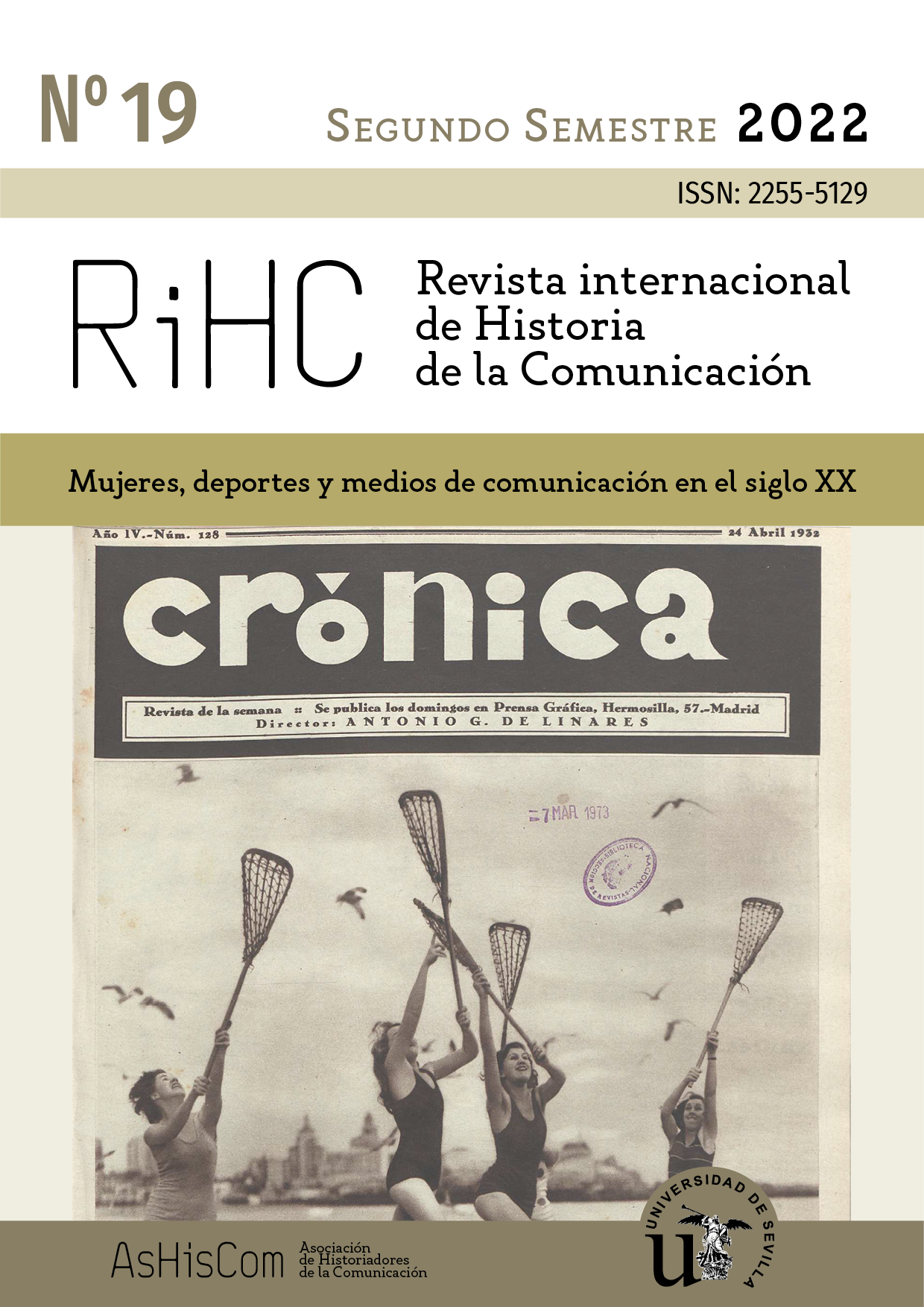El periodismo cinematográfico de Irene Polo (1927-1930). Acotaciones a un trabajo inédito
DOI:
https://doi.org/10.12795/RiHC.2022.i19.08Palabras clave:
Periodismo y género, Irene Polo, Gaumont, cine mudo, prensa cinematográficaResumen
Irene Polo trabajó en algún momento de su juventud como representante en la prensa de la productora cinematográfica francesa Gaumont. Este artículo se propone localizar el trabajo que desarrolló como propagandista de dicha empresa. Tras rastrear la prensa especializada en cine de Barcelona entre 1927 y 1930, se han localizado ocho artículos inéditos firmados (1927), uno atribuido (1927), dos alusiones directas a su nombre (1927 y 1929) y dos fotografías en las que Polo aparece presentada en 1927 y en 1928 como una periodista en activo. Esta actividad es anterior al momento en que se situaba hasta ahora su debut: mayo de 1930 en la revista Imatges de Barcelona. No comienza como periodista a los 21 años, como se pensaba, sino con 18. Tampoco escribió casi siempre en catalán, sino que también lo hizo en castellano. Polo trabajó durante el periodo de estudio en el periódico El Día Gráfico (1927) y en las revistas El Cine (1927-1928) e Información Cinematográfica (1929) durante períodos todavía no delimitados. En este sector llevó a cabo su inserción y aprendizaje. Pese a su juventud, firmó algunos trabajos muy significativos. Se resitúa así la biografía profesional de una de las periodistas más innovadoras de la Segunda República.
Descargas
Citas
ALBA, V. (1996). Sísifo y su tiempo: memorias de un cabreado (1916-1996). Barcelona: Laertes.
ALBERTÍ, E. (2015) Compromeses. Vuit dones catalanes excepcionals. Barcelona: Al-bertí y Ajuntamiento de Barcelona.
ALTÉS, E. (2007). Les Periodistes del temps de la República. Col.legi de Periodistes de Catalunya: Barcelona
ARTÍS-TOMÀS, A. A (1977) “Última Hora memorable”, Avui, 7 de agosto, p. 18
― (2000) “Andreu Avel.lí Artís o Sempronio el caballero de la ciudad” [Entre-vista de Núria Escur]. Barcelona Metròpolis Mediterrània, 52 (julio), pp. 25-31
ARROYO CABELLO, M. (2021). “Rompiendo moldes: María Luz Morales y la crónica femenina”. RIHC: Revista Internacional de Historia de la Comunicación, 16, pp. 65-92. DOI: 10.12795/RiCH.2021.i16.04
BELLMUNT, D. de (1975). Cinquanta anys de periodisme català: 1923-1975. Andorra la Vella: Mirador del Pirineu.
CASAS HONRADO, M. (2014) “Irene Polo. Bocetos de la vida y la obra de una perio-dista meteórica”, en III Congreso Internacional de Literatura y Cultura Españo-las Contemporáneas, 8, 9 y 10 de octubre de 2014, La Plata, Argentina.
CASASÚS i GURÍ, J. M. (1996). Periodisme català que ha fet història. Barcelona: Proa, pp. 340-343.
― (2008): “La recerca en periodística contra la desmemòria històrica: quatre memòries joves estroncades” Treballs de Comunicació. pp. 11-19. DOI: 10.2436/20.3008.01.3
FARIÑA BUSTO, M. J. (2019). “El beso deseado de tu boca. Nombres y voces para una ginealogía lesbiana (España y Portugal, primeras décadas del siglo veinte)”, en Investigaciones feministas 10.1, pp. 79-96. DOI: 10.5209/INFE.61064
DORIA ALBURQUERQUE, S. (1999). La voluntad cosmopolita. Imatges semanario gráfi-co de actualidades. Tesis doctoral. Universitat Autònoma de Barcelona.
― (2008): “Imatges, el quilòmetre zero d’Irene Polo”. Treballs de Comunicació. Núm. 24, pp. 55-70. DOI: 10.2436/20.3008.01.37
GUILLAMET, J. (2022) El periodismo català contemporani. Diaris partits polítics i llen-gües, 1873-1939. Barcelona: Institut d’Estudis Catalans.
HERNÁNDEZ, A. (2009). Testimonios en huecograbado: el cine de la 2ª República y su prensa especializada (1930-1939). Valencia: Ediciones de la Filmoteca.
JULIO, T. (2017). «Irene Polo, una traductora transatlàntica a l’exili». En Albert, C.; Friedlein, R.; Martí, I. (ed.). Els catalans i Llatinoamèrica (s. XIX i XX): Viatges, exilis i teories. Barcelona: Publicacions de l’Abadia de Montserrat, pp. 243-250.
JULIO, T. (2018) “Irene Polo, traductora de Pride and Prejudice: una història d’adversitats”. Quaderns: Revista de traducció, 25, pp. 87-97
MADRID, F. (1937) “Irene Polo parla de Margerita Xirgu i nosaltres parlem d’Irene Polo”. Catalunya (Buenos Aires), 77 (abril), pp. 18-19 y 21.
LÁZARO, E.; SALGADO, F. (2020). “María Luz Morales, directora de La Vanguardia (1936-1937)”. Historia y comunicación social, 25(2), pp. 299-308. DOI: 10.5209/hics.72266
NIETO, J. (2019). “La prensa cinematográfica española como fuente y objeto de la historia del cine. Análisis y evolución de sus contenidos (1910-2010)”. Historia y comunicación social, 24 (1), pp. 237-258. DOI: 10.5209/HICS.64493
NIETO, J. y MONTERDE, J. E. (2019): La prensa cinematográfica en España (1910-2010). Santander: Shangrila.
PESARRODONA, M. (2006). Donasses. Protagonistes de la Catalunya moderna. Barce-lona: Destino.
REAL, N. (2004). Dona i literatura en els anys trenta. La narrativa de les escriptores catalanes fins a la Guerra Civil. Tesis doctoral. Universitat Autònoma de Barce-lona.
RODRIGO, A. (1979). Mujeres de España: las silenciadas. Barcelona: Plaza & Janés.
SANTA-MARIA, G. y TUR, N. (ed) (2003). La Fascinació del periodisme : cròniques (1930-1936). Barcelona: Quaderns Crema.
― (2022). Els anys americans d’Irene Polo. Barcelona: Cal Carré.
SENTÍS, C. (2003) “Un llibre, una periodista i una época”. Avui, 20 de abril, p. 24.
Descargas
Publicado
Cómo citar
Número
Sección
Licencia
Derechos de autor 2022 RIHC. Revista Internacional de Historia de la Comunicación

Esta obra está bajo una licencia internacional Creative Commons Atribución-NoComercial-CompartirIgual 4.0.
RiHC. Revista internacional de Historia de la Comunicación es una publicación de acceso libre, ofrece su contenido bajo el principio de que hacer disponible gratuitamente la investigación al publico apoya a un mayor intercambio de conocimiento global.
RIHC. Revista internacional de Historia de la Comunicación se adhiere a las diferentes iniciativas que promueven el acceso libre al conocimiento, por lo que todos los contenidos son de acceso libre y gratuito y se publican bajo licencia de Creative Commons Reconocimiento-NoComercial 4.0 Internacional.

En virtud de ello, los autores que publiquen en esta revista aceptan las siguientes condiciones:
Los autores conservan los derechos de autor y ceden a la revista el derecho de la primera publicación, con el trabajo registrado con la licencia de atribución de Creative Commons, que permite a terceros utilizar lo publicado siempre que mencionen la autoría del trabajo y a la primera publicación en esta revista.
Los autores pueden realizar otros acuerdos contractuales independientes y adicionales para la distribución no exclusiva de la versión del artículo publicado en esta revista (p. ej., incluirlo en un repositorio institucional o publicarlo en un libro) siempre que indiquen claramente que el trabajo se publicó por primera vez en esta revista.
Se permite y recomienda a los autores publicar su trabajo en Internet (por ejemplo en páginas institucionales o personales) ya que puede conducir a intercambios productivos y a una mayor y más rápida difusión del trabajo publicado (vea The Effect of Open Access).
No prevé moving wall o período de embargo
Debe utilizarse la versión de editor/PDF
La fuente editorial debe reconocerse



